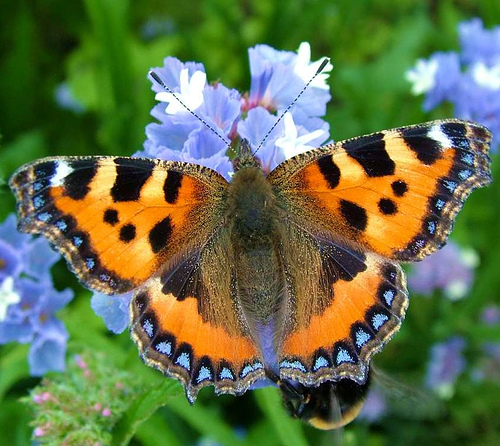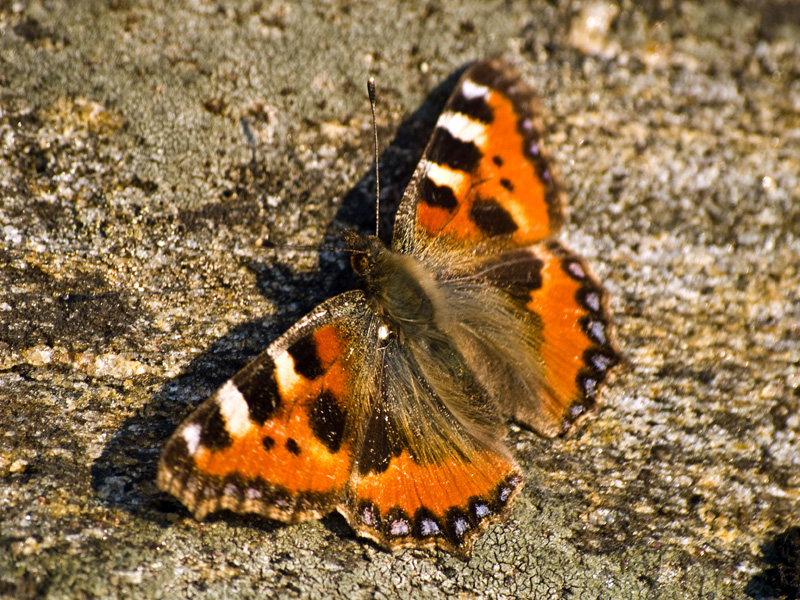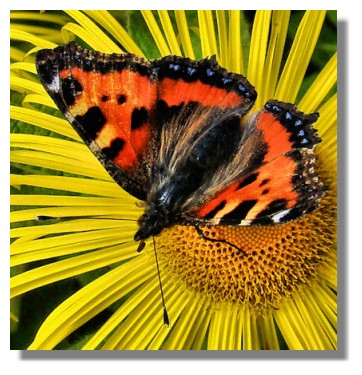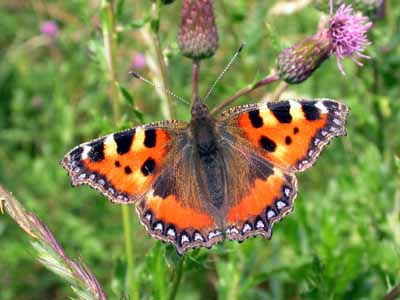small tortoiseshell
Butterflies feed on the nectar of flowers, so if you want to see an increase in the number of butterflies visiting your garden, you will want to ensure you plant the right kind of flowers and shrubs in your garden. It is also worth remembering that some butterflies will only lay their eggs on specific plants, so you can help to ensure the future survival of these species too.
Taking into account flowers and shrubs for the different seasons is important too, as you will want to provide them with a steady supply of food and ensure your garden is a haven for these beautiful insects, no matter what the time of year. Here is a list of ten plants to get your butterfly garden off to a flying start.
Primrose -The Primrose is a hardy bloomer that comes in a variety of colours, including yellow and purple. It is also a very fragrant flower. Primroses flower in the spring and can bloom all through summer, especially if planted in the shade.
Common Nettle - If planted in a sunny spot, the common stinging nettle is a perfect place for Peacock, Small Tortoiseshell, Red Admiral butterflies to lay their eggs on in June. The caterpillars will then be seen munching on the leaves from July, sometimes right through to November.
Wallflower - The Wallflower is a short lived perennial, available in a variety of colours that will bloom from spring and throughout summer. Established plants will easily self seed too.
Buddleia (otherwise known as the butterfly bush) - Depending on the variety, this will flower throughout spring and summer, sometimes through to autumn. It is available as a shrub or tree, with evergreen and deciduous species available. The flowers are strongly scented and vary in colour including white, purple and pink.
Lavender or Lavandula - This flowers in summer through to autumn and has a lovely scent. It is best to plant a few together and they prefer dry, well drained soil in full sun.
Ice Plant - Flowering in the summer through to late autumn. It usually has lots of tiny pink flowers. Prefers being planted in full sun.
Common Ivy - is a common and evergreen climber. Its light yellow flowers appear from September to October, providing an essential source of late nectar for butterflies.
Common Dog Violet - Is a variety of wildflower that flowers in March through to May. It isn't really scented but attracts the various types of Fritillary butterfly, who will lay eggs on it.
Lilac or Syringa - This is a deciduous shrub that is hardy and flowers from May to June. It usually has scented white or pink flowers.
Hebes - The 'Great Orme' variety is one of the best types to plant to attract butterflies, although the others will still attract some. All Hebes are evergreen and can flower for several months.
Taking into account flowers and shrubs for the different seasons is important too, as you will want to provide them with a steady supply of food and ensure your garden is a haven for these beautiful insects, no matter what the time of year. Here is a list of ten plants to get your butterfly garden off to a flying start.
Primrose -The Primrose is a hardy bloomer that comes in a variety of colours, including yellow and purple. It is also a very fragrant flower. Primroses flower in the spring and can bloom all through summer, especially if planted in the shade.
Common Nettle - If planted in a sunny spot, the common stinging nettle is a perfect place for Peacock, Small Tortoiseshell, Red Admiral butterflies to lay their eggs on in June. The caterpillars will then be seen munching on the leaves from July, sometimes right through to November.
Wallflower - The Wallflower is a short lived perennial, available in a variety of colours that will bloom from spring and throughout summer. Established plants will easily self seed too.
Buddleia (otherwise known as the butterfly bush) - Depending on the variety, this will flower throughout spring and summer, sometimes through to autumn. It is available as a shrub or tree, with evergreen and deciduous species available. The flowers are strongly scented and vary in colour including white, purple and pink.
Lavender or Lavandula - This flowers in summer through to autumn and has a lovely scent. It is best to plant a few together and they prefer dry, well drained soil in full sun.
Ice Plant - Flowering in the summer through to late autumn. It usually has lots of tiny pink flowers. Prefers being planted in full sun.
Common Ivy - is a common and evergreen climber. Its light yellow flowers appear from September to October, providing an essential source of late nectar for butterflies.
Common Dog Violet - Is a variety of wildflower that flowers in March through to May. It isn't really scented but attracts the various types of Fritillary butterfly, who will lay eggs on it.
Lilac or Syringa - This is a deciduous shrub that is hardy and flowers from May to June. It usually has scented white or pink flowers.
Hebes - The 'Great Orme' variety is one of the best types to plant to attract butterflies, although the others will still attract some. All Hebes are evergreen and can flower for several months.
small tortoiseshell
small tortoiseshell
small tortoiseshell
small tortoiseshell
small tortoiseshell
small tortoiseshell
small tortoiseshell
small tortoiseshell
small tortoiseshell
small tortoiseshell
small tortoiseshell
small tortoiseshell
small tortoiseshell
small tortoiseshell
small tortoiseshell
small tortoiseshell
small tortoiseshell
small tortoiseshell

.gif)












.jpg)



